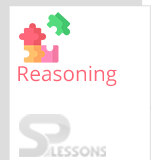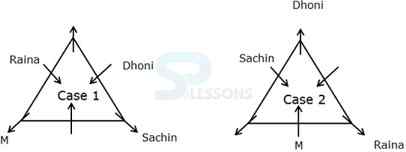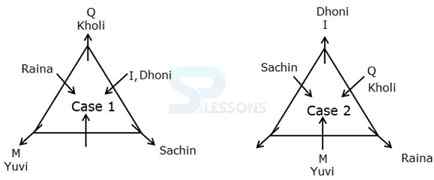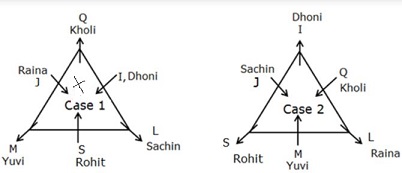 Introduction
Introduction
What is Reasoning Ability Test?
A logical reasoning test is a form of psychometric testing that is widely used by corporate employers to help assess candidates during their recruitment process. 'Psychometric' is just a fancy way of saying 'measuring mental ability' and logical reasoning tests are designed to measure your non-verbal skills.
The article SSC CPO Reasoning Ability Quiz 8 provides Reasoning Ability questions with answers useful to the candidates preparing for Competitive exams, Entrance exams, Interviews etc.
 Quiz
Quiz
Direction(1-5): Study the information given below and answer the questions based on it.
Six persons A, B, C, D, E and F has weekend on seven different days of the week starting from Sunday to Saturday but not necessarily in the same order.
D has weekend on after Wednesday. Two persons has weekend between E and F. F has weekend on after C. C has weekend on two days after B. Number of person has weekend on before B is as same as after A. E doesn’t have weekend before B. Wednesday is not the weekend for C.
1. Who among the following has weekend on Thursday?
2. Answer - Option B
3. Answer - Option B
4. Answer - Option C
5. Answer - Option E
- A. A
B. B
C. C
D. D
E. None of these
- A. Monday
B. Tuesday
C. Wednesday
D. Thursday
E. None of these
- A. Sunday
B. None of these
C. Monday
D. Thursday
E. Saturday
- A. One
B. Two
C. Three
D. None
E. More than three
- A. B – Sunday
B. D – Thursday
C. C – Tuesday
D. All are correct
E. F – Saturday
| Days | Person |
|---|---|
| Sunday | B |
| Monday | E |
| Tuesday | C |
| Wednesday | XXXX |
| Thursday | D |
| Friday | F |
| Saturday | A |
- C has weekend on two days after B.
- Two persons has weekend between E and F.
- F has weekend on after C.
- E doesn’t have weekend before B.
- D has weekend on after Wednesday.
- Wednesday is not the weekend for C.
- Number of person has weekend on before B is as same as after A. From these above statements B should have weekend on either Sunday or Monday. If B has weekend on Monday then it won’t satisfy the second statement. So B should have weekend on Sunday. Then C has weekend on Tuesday. E has weekend on either Monday or Wednesday because F has weekend on after C. If E has weekend on Wednesday then F should has weekend on Saturday. In this scenario we cannot fix A. So E should not have weekend on Wednesday. Hence E has weekend on Tuesday. Two possible cases, case 1 and case 2. But in case 1 doesn’t satisfy second statement so this case is eliminated and case 2 will be the final arrangement.
| Days | Case 1 Person | Case 2 Person |
|---|---|---|
| Sunday | B | B |
| Monday | E | E |
| Tuesday | C | C |
| Wednesday | XXXX | XXXX |
| Thursday | F | D |
| Friday | D | F |
| Saturday | A | A |
Direction(1-3): Study the information given below and answer the questions based on it.
Six persons M, L, I, J, Q and S are sitting in a triangular table, Such that three of them sitting at corners of the table and three are sitting at middle of the each side. The persons who are sitting at corners are facing outside the centre and the person who sitting at middle of the sides are facing centre of the table. They like different Cricket players namely Dhoni, Sachin, Kholi, Raina, Rohit and Yuvi.
Q likes Kholi and sits second to right of the one who like Yuvi. J doesn’t faces opposite to the center. Only I sit immediate left of the one who like Sachin. L and J are not immediate neighbours. The one who like Rohit sits Second to the right of L. S doesn’t like Sachin. Two people sit between the one who like Sachin and the one who like Raina. Two People sits between M and the one who like Dhoni. The one who likes Raina sits second to the right of the one who like Dhoni.
1. Who sits second to the right of the one who like Yuvi?
An even number is followed by an odd number (prime number) 4 + 7 = 11
The row is 11 4, an odd number is followed by an even number (not a cube number) 11 × 4 = 44(resultant of first row)
X is double the value of resultant of the first row, So X is 88.
An even number is followed by an odd number (but not a perfect square) 6 + 7 = 13
The row is 13 88, an odd number is followed by an even number, 13 × 88 = 1144
5. Answer - Option C
Explanation -
An even number is followed by an odd 33 + 21 = 55
The row is 55 64 , an odd number is followed by a perfect cube 64 - 55 = 9
- A. The one who like Sachin
B. The one who sits second to the left of J
C. The one who like Raina
D. J
E. None of these
- A. Third to the right
B. Immediate left
C. Second to the left
D. Second to the right
E. Immediate right
- A. I, S, Q
B. S, J, M
C. L, M, I
D. None of these
E. M, J, Q
| 4 | 7 | 4 |
| 6 | 7 | X |
- A. 484
B. 2144
C. 1444
D. 1144
E. None of these
| 3 | 7 | 35 |
| 24 | 31 | 64 |
- A. 81
B. 59
C. 9
D. 82
E. None of these
| 4 | 7 | 4 |
| 6 | 7 | X |
| 6 | 7 | 88 |
| 24 | 31 | 64 |
Direction(1-3): Study the following information carefully and answer the questions given below.
‘A × B’ means ‘A is son of B’.
‘A + B’ means ‘A is daughter of B’.
‘A ÷ B’ means ‘A is wife of B’.
‘A – B’ means ‘A is father of B’.
1. In the expression ‘Z + J – P ? X’, what will come in place of ? if X is mother of Z?
- A. +
B. -
C. ÷
D. ×
E. cannot be determined
- A. R is brother of O
B. S is daughter-in-law of K
C. S is daughter-in-law of O
D. O is daughter of Z
E. None of these
- A. +
B. -
C. ÷
D. ×
E. None of these
- A. 2 km
B. 3 km
C. 1 km
D. 2.5 km
E. None of these
- A. East
B. West
C. North
D. South
E. None of these








